Telemedicine Market Research, 2032
The global telemedicine market size was valued at $84.3 billion in 2022, and is projected to reach $451.4 billion by 2032, growing at a CAGR of 18.3% from 2023 to 2032. Telemedicine is a modern healthcare system that allows healthcare professionals to evaluate, diagnose, and treat patients from a distance using telecommunications technologies. The approach has strikingly evolved in the last decade, and it is becoming an increasingly important part of the healthcare infrastructure.
In the early days, telemedicine was used mostly to connect doctors working with a patient in one location to specialists somewhere else. Telemedicine leverages the power of various forms of Information and Communication Technology (ICT) to deliver healthcare services from one location to another. This was of great benefit to rural or hard to reach populations where specialists aren’t readily available. The benefits of telemedicine include improved access to healthcare services, reduced healthcare costs, and increased patient satisfaction due to the convenience of time.
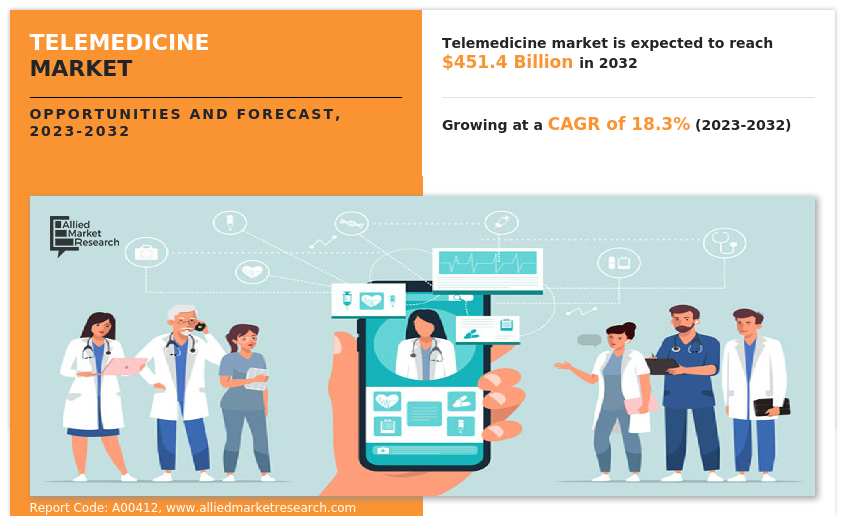
Market Dynamics
The telemedicine market growth is driven by increase in demand for healthcare services and technological advancement in telemedicine. Telemedicine saves both the patient and the healthcare provider’s time and cost of treatment. Furthermore, it streamlines the workflow of hospitals and clinics. This factor has increased the demand for healthcare services which drives the growth of the telemedicine market.
Furthermore, increase in prevalence of chronic diseases fuels the expansion of telemedicine through remote patient monitoring. Telemedicine is accessible for patients suffering from various chronic diseases such as heart disease, cancer, or diabetes for regular and lifelong disease management. For instance, National Cancer Institute (NCI), in 2020, reported that about 70% patients with the highest socioeconomic status had a telemedicine visit within 30 days of their cancer diagnosis. Further, it is estimated that the patient in highest socioeconomic group continued to have high rates of telemedicine use in subsequent month.
In addition, reduction in the healthcare cost by using telemedicine further boosts its adoption among the diseased population. For instance, in 2023, National Cancer Institute (NCI), reported that patients under age 65 saved on indirect costs by using telehealth visits compared to the costs of visiting their doctors in person. In addition, as per the same source, the use of telehealth was associated with average cost saving of $100 to $200 per visit of patient. Thus, cost-effective and easy accessibility of these services further drives the growth of telehealth market.
Furthermore, increase in partnership and collaboration by the key market players for expansion of telemedicine services also propels the market growth. For instance, in August 2022, Teladoc Health, a global leader in telehealth market, partnered with Cloud DX company to expand remote patient monitoring across Canada. In addition, in December 2021, Teladoc Health partnered with National Labor Alliance of Health Care Coalitions (NLA) to offer its virtual care services. Such partnership will expand the telemedicine services of Teladoc Health across other countries.
However, increase in data breaches of patient’s confidential information negatively impacts the market growth. On the other hand, introduction of new products in the market are expected to create lucrative opportunities for growth of the telemedicine market. For instance, in August 2021, GE Healthcare, a leading player in healthcare industry, launched its Edison True PACS, a diagnostic imaging and workflow solution. This solution helps radiologists to transfer patient images, such as X-rays, CTs, and MRIs from one location to another. In addition, in June 2020, Siemens Healthineers, a subsidiary company of Siemens AG, launched its teamplay myCare Companion software that enables remote care for patients with chronic diseases.
Recession can be defined as the slow down of economic activities which may last for some quartes which hampers the growth of an ecomomy. This leads to a significant fall in economic spending. The economic recession has a moderate impact on the telemedicine market owing to reduced investor willingness to invest in telemedicine companies due to the economic uncertainty, which leads to funding challenges for these companies. However, telemedicine offers cost-savings as compared with the traditional visits to hospital. Thus, patient can save on travel and time-off-work expenses, which reduces the overall cost of the treatment. Thus, telemedicine market is moderately impacted by the recession.
Segmental Overview
The telemedicine market is segmented on the basis of component, application, end user, and region. On the basis of component, the market is segmented into software, hardware, and services. As per application, the market is categorized into teleradiology, telepsychiatry, telepathology, teledermatology, telecardiology, and other applications. By end user, it is divided into healthcare providers, payers, and healthcare consumers. Region wise, the market is analyzed across North America (the U.S., Canada, and Mexico), Europe (Germany, France, the UK, Italy, Spain, and rest of Europe), Asia-Pacific (China, Japan, Australia, India, South Korea, and rest of Asia-Pacific), and LAMEA (Brazil, South Africa, Saudi Arabia, and rest of LAMEA).
By Component
The telemedicine market is segmented into software, hardware, and services. The service segment accounted for the largest market share in 2022. This is attributed to increase in telemedicine services for telecardiology and telepsychiatry. However, software segment is expected to register fastest CAGR during the forecast period, as it enables healthcare providers to conduct virtual consultations, schedule appointments, and maintain electronic health records (EHR). In addition, development of advanced software by integrating machine learning and artificial intelligence drives the adoption of software. Moreover, availability of various software, ease of use, and easy accessibility further boosts the segment growth.
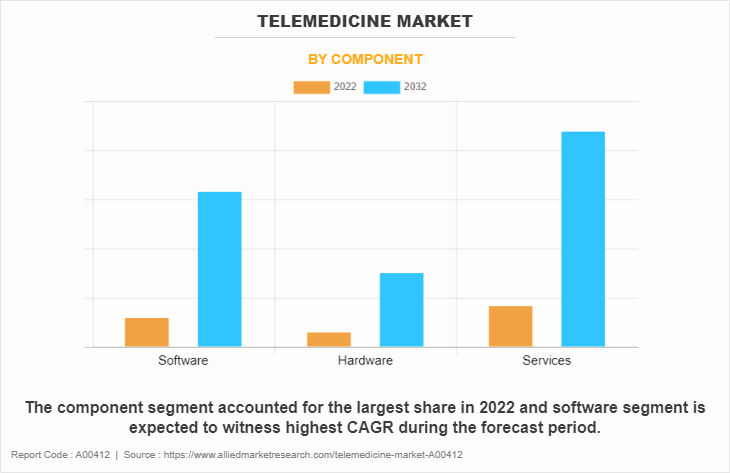
By Application
The telemedicine market is segregated into teleradiology, telepsychiatry, telepathology, teledermatology, telecardiology, and other applications. The telecardiology segment accounted for the largest market share in 2022. This is attributed to development of new telecardiology software and increase in the prevalence of hypertension, stroke, and other cardiovascular diseases which boost the adoption of telecardiology. However, telepsychiatry segment is expected to be the fastest growing segment during the forecast period, owing in surge in awareness about mental health importance and management of mental health.
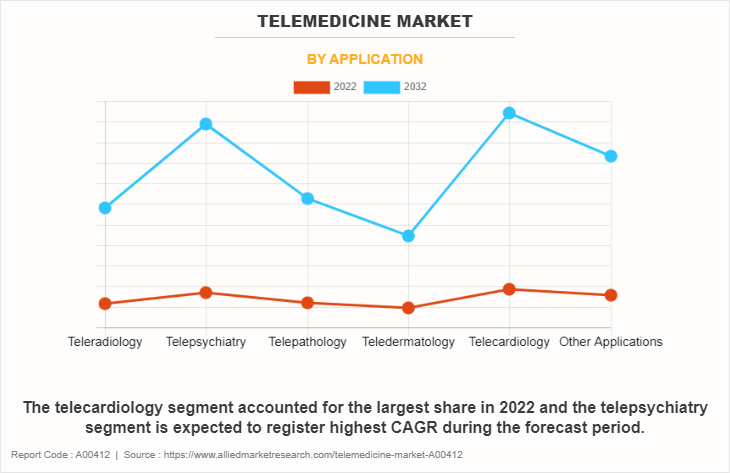
By End User
The telemedicine market is segmented into healthcare providers, payers, and healthcare consumers. Healthcare provider segment dominated the global market in 2022. This is attributed to increase in adoption of new technologies and software in hospital settings and clinics to access patient data easily and schedule patient appointments. However, healthcare consumers is expected to be the fastest growing segment during the telemedicine market forecast period, owing to easy accessibility of telemedicine through various mobile applications.
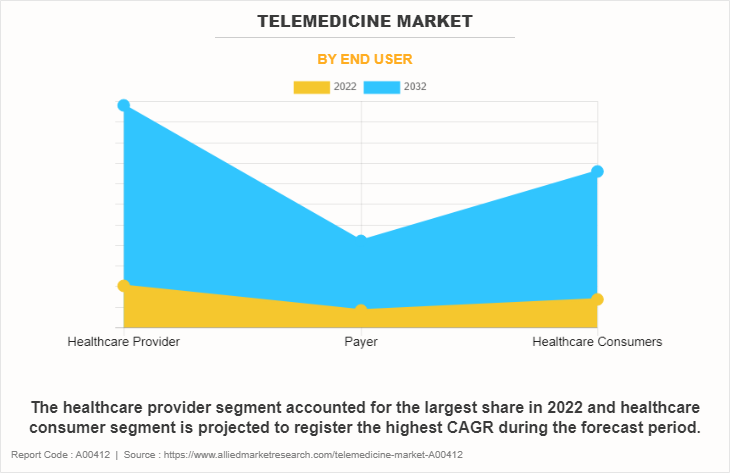
By Region
The telemedicine market is analyzed across North America, Europe, Asia-Pacific, and LAMEA. North America accounted for a major share of the telemedicine market size in 2022 and is expected to maintain its dominance during the forecast period. North America offers profitable telemedicine market opportunity due to presence of several major players, such as AMC Health, American Well Corporation, and Teladoc Health, Inc., and surge in diseases burden in the region drive the growth of the market. For instance, according to National Diabetes Statistics Report 2020 provided by Centers for Disease Control and Prevention (CDC), it was estimated that about 34.2 million people (10.5%) in the U.S. population have diabetes. Increase in prevalence of diabetes leads to greater demand for disease management which drives the adoption of telemedicine solutions and further drives the growth of telehealth market.
In addition, presence of developed healthcare infrastructure in this region further drives the growth of the market. Furthermore, increase in healthcare awareness and acceptance of cloud-based technologies over the forecast period is expected to drive the market growth. Asia-Pacific is expected to grow at the highest rate during the forecast period. The market growth in this region is attributable to the increase in demand for telemedicine services to manage the diseased population and rise in prevalence of chronic diseases.
Asia-Pacific region has a large population, and there has been an observed increase in the prevalence of cancer in recent years due to ageing population, lifestyle changes, and environmental factors. This has led to an increase in remote patient monitoring, which in turn increases the demand for telemedicine. For instance, in 2020, National Institute of Cancer Prevention and Research (NICPR), estimated that about 2.7 million people in India are living with cancer. In addition, growing adoption of telemedicine further propels the market growth. Asia-Pacific offers profitable opportunities for key players operating in the telemedicine market, thereby registering the fastest growth rate during the forecast period, owing to the rise in disposable income, as well as increase in healthcare expenditure.
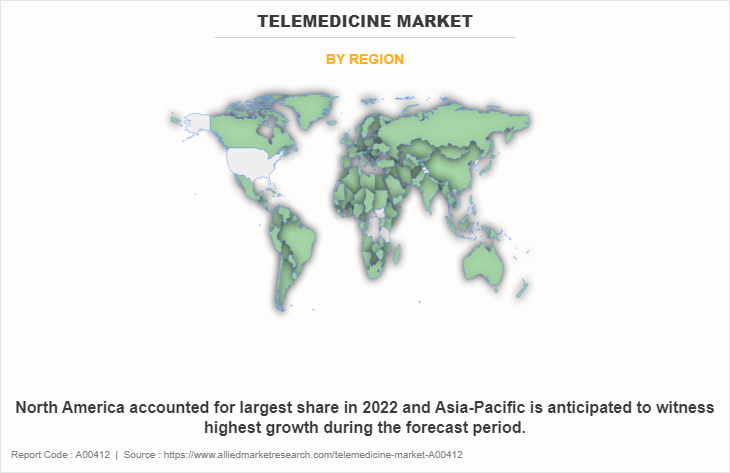
Competition Analysis
Competitive analysis and profiles of the major players in the telemedicine market includes AMC Health, American Well Corporation, Cerner Corporation, Cisco Systems, Inc., General Electric Company, Koninklijke Philips N.V., Cigna Corporation, Siemens AG, Teladoc Health, Inc., and Medtronic Plc. Major players have adopted product launch, partnership, collaborations, and acquisition as key developmental strategies to improve the product portfolio and gain strong foothold in the market.
Recent Partnership in the Telemedicine Market
In May 2023, AMC Health, a health care company, partnered with University of Mississippi Medical Center to improve care for patients with chronic conditions. This partnership will expand patient care beyond hospital and drives the growth of telemedicine industry
In August 2022, AMC Health, a leading telemedicine provider, partnered with a Magnolia Regional Health Center (MRHC), to expand remote care services for patients with congestive heart failure (CHF), COPD, diabetes, and hypertension. This partnership will help to expand the telemedicine services.
Recent Product Launch in the Telemedicine Market
In June 2021, AMC Health, a global provider in telehealth technology, has launched new interactive voice response (IVR) solutions in collaboration with eviCore Healthcare to support patients living with Coronavirus (COVID-19) and respiratory symptoms.
In January 2021, Amwell, one of the global leader in telehealth launched its Amwell Psychiatric Care solution which provides hospitals and health systems with on-demand and scheduled telepsychiatry services. Such product launches will help the company to gain strong foothold in the telemedicine industry.
Recent Collaboration in the Telemedicine Market
In October 2022, AMC Health collaborated with GE Healthcare, a global healthcare company, to pair AMC Health’s Remote Patient Monitoring suite with GE Healthcare’s clinical monitoring platform to extend patient care outside the hospital.
Recent Acquisition in the Telemedicine Market
In August 2021, Amwell acquired SilverCloud Health and Conversa Health to expand its digital care platform. This acquisition will help to expand the telemedicine product portfolio of Amwell.
Key Benefits For Stakeholders
- This report provides a quantitative analysis of the market segments, current trends, estimations, and dynamics of the telemedicine market analysis from 2022 to 2032 to identify the prevailing market opportunities.
- The market research is offered along with information related to key drivers, restraints, and opportunities.
- Porter's five forces analysis highlights the potency of buyers and suppliers to enable stakeholders make profit-oriented business decisions and strengthen their supplier-buyer network.
- In-depth analysis of the telemedicine market segmentation assists to determine the prevailing market opportunities.
- Major countries in each region are mapped according to their revenue contribution to the global market.
- Market player positioning facilitates benchmarking and provides a clear understanding of the present position of the market players.
- The report includes the analysis of the regional as well as global telemedicine market trends, key players, market segments, application areas, and market growth strategies.
Telemedicine Market Report Highlights
| Aspects | Details |
| Market Size By 2032 | USD 451.4 billion |
| Growth Rate | CAGR of 18.3% |
| Forecast period | 2022 - 2032 |
| Report Pages | 273 |
| By Component |
|
| By Application |
|
| By End User |
|
| By Region |
|
| Key Market Players | American Well Corporation, Siemens AG, AMC Health, LLC, Koninklijke Philips N.V., Oracle Corporation, Teladoc Health Inc., General Electric Company, The Cigna Group, Medtronic plc, Included Health Inc. |
Analyst Review
Telemedicine is defined as the delivery of healthcare from a distance using electronic information and technology such as video conferencing, wireless communications, computers, and the internet. It allows healthcare professionals to evaluate, diagnose, and treat patients without the need for an in-person visits. Telemedicine is majorly used in chronic disease management, medication management, and follow-up appointments.
Furthermore, increase in partnership and collaborations by the market key players are expected to create opportunities for the market growth. For instance, in May 2023, AMC Health, a health care company partnered with University of Mississippi Medical Center, aims to improve care for patients with chronic conditions. This partnership will expand patient care beyond hospital. Furthermore, March 2023, Amwell, one of the global leader in digital healthcare, partnered with DarioHealth to expand its digital clinical programs. In addition, AMC Health collaborated with GE Healthcare, a global healthcare company, in October 2022, for increasing patient care outside the hospital and to expand GE Healthcare’s clinical monitoring platform.
The total value of telemedicine market is $84,249.11 million in 2022.
The value of telemedicine market in 2032 is $451,444.10 million.
Top companies such as, Teladoc Health, Siemens AG, The Cigna Group, American Well Corporation, and Medtronic plc held a high market position in 2022. These key players held a high market position owing to the strong geographical foothold in different regions.
Service is the most influencing segment growing in telemedicine market, due to increase in adoption of telemedicine services by the consumers and surge in adoption of remote patient monitoring.
The major factor that fuels the growth of the telemedicine market are surge in adoption of remote patient monitoring post COVID-19 pandemic, technological advancements in the telemedicine solutions, and increase in funding from government to adopt telemedicine in healthcare settings.
Asia-Pacific has the highest growth rate in the market which is growing due to the contribution of the following emerging countries such as China, Japan, and India. This is due to increasing adoption of telehealth and telemedicine in healthcare facilities and consumers.
The forecast period for telemedicine market is 2023 to 2032.
The base year is 2022 in telemedicine market.
Telemedicine is the remote patient monitoring from distance by using various teleconference solutions.
Loading Table Of Content...
Loading Research Methodology...


